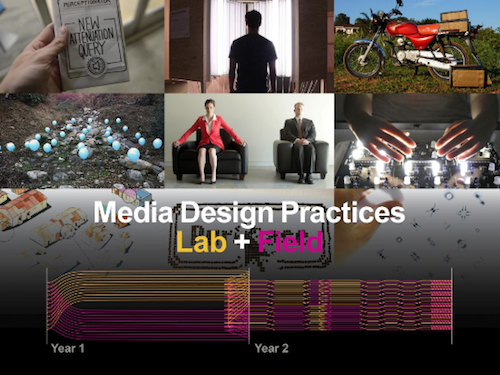
This Fall, UNICEF’s Innovation Lab in Kampala, Uganda, will embark upon its third year working with graduate students and faculty from Media Design Practices (MDP) at Art Center College of Design. The partnership is integrated into the design program’s unique curriculum, which recently received the prestigious 2014 Core 77 Design Award.
Student work with Ugandan youth was a significant factor in Core 77’s decision to recognize MDP with this honor. Students’ first-hand experience designing technology in a developing world context contributed to what the jury recognized as “…the kind of pure research in education that we believe is the future of education—through [a curriculum] that is not removed from the world because of the way that [it is] embedded in the world.”
In keeping with UNICEF’s Innovation approach, faculty and students, “…are actually practicing what they preach, they are testing their model as it is moving along.” Using the Innovation Lab as a studio base, the students grapple with issues that Innovation Lead Chris Fabian outlines in his recent Stanford Social Innovation Review post on The Ethics of Innovation—including such thorny questions as: “How do we design in an inclusive and participatory manner, when resource and power dynamics are so unequal?”
The partnership has led to numerous community-based projects as well as internships and staff positions within the Innovation Unit. 2013 graduate Jeff K. Hall is taking his graduate school experience into his work as UNICEF Indonesia Innovation Lab Lead. Tina L. Zeng’s weDub is an electronic device that makes the technology behind VJing accessible to youth. Whereabouts is a speculative design project by Jeff Hall’s classmates Jacob Brancasi and Betsy Kalven. The latter project was also a 2014 Core 77 Design Award winner.
But that is only half of the story for the MDP curriculum interweaves two distinct tracks that prepare design students to work on global issues with emerging ideas from science, technology, and culture. The UNICEF partnership is central to the track called “Field”–which is run in partnership with Art Center’s Designmatters– in which students use design to address issues of social inequality. Meanwhile, students in the parallel “Lab” track bring design to advances in science and technology .
It is the exchange between the two tracks that stood out to the Core 77 jury. Mixing perspectives and contexts in the curriculum led the jury to proclaim: “This is a compelling experiment in structuring an interdisciplinary academic curriculum. If you’re not thinking this way, you might as well be thinking about the horse and buggy.”









This post really touched me and the designs are just amazing thank you for taking the time to make this article i’m going to go sob alittle bit…
Having read this I thought it was extremely informative.
I appreciate you taking the time and energy to put this
content together. I once again find myself spending a significant
amount of time both reading and commenting. But so what, it was still
worthwhile!